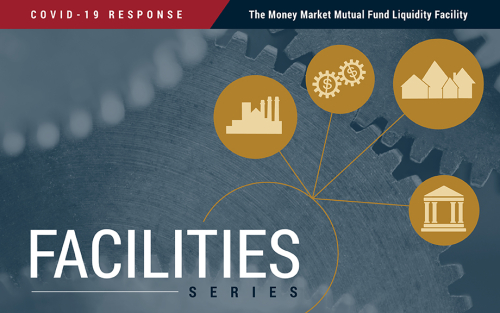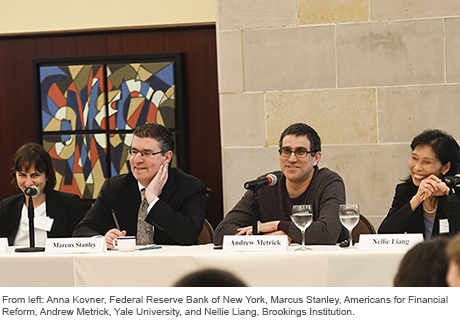Nonbanks and Banks: Alone or Together?

Nonbank financial institutions (NBFIs) constitute a variety of entities—fintech companies, mutual funds, hedge funds, insurance companies, private debt providers, special purpose vehicles, among others—that have become important providers of financial intermediation services worldwide. But what is the essence of nonbank financial intermediation? Does it have any inherent advantages, and how does it interact with that performed by banks? In this Liberty Street Economics post, which is based on our recent staff report, we provide a model-based survey of recent literature on nonbank intermediation, with an emphasis on how it competes, or cooperates, with traditional banks.
The Origins of Market Power in DeFi

In our previous Liberty Street Economics post, we introduced the decentralized finance (DeFi) intermediation chain and explained how various players have emerged as key intermediaries in the Ethereum ecosystem. In this post, we summarize the empirical results in our new Staff Report that explains how the need for transaction privacy across the DeFi intermediation chain gives rise to intermediaries’ market power.
The DeFi Intermediation Chain

Decentralized Finance, or DeFi, is a rapidly growing ecosystem of financial applications built on blockchain technology, primarily on the Ethereum network. These applications aim to recreate traditional financial instruments and services, such as lending, borrowing, trading, and insurance. The DeFi intermediation chain connects a series of intermediaries who find arbitrage opportunities, aggregate transactions into blocks, validate these blocks, and ultimately append them to the blockchain. In this post, we summarize results from our staff report describing how arbitrage opportunities arise in the Ethereum blockchain, and how the need to keep these arbitrage opportunities private gives rise to the intermediation chain.
Understanding the “Inconvenience” of U.S. Treasury Bonds

The U.S. Treasury market is one of the most liquid financial markets in the world, and Treasury bonds have long been considered a safe haven for global investors. It is often believed that Treasury bonds earn a “convenience yield,” in the sense that investors are willing to accept a lower yield on them compared to other investments with the same cash flows owing to Treasury bonds’ safety and liquidity. However, since the global financial crisis (GFC), long-maturity U.S. Treasury bonds have traded at a yield consistently above the interest rate swap rate of the same maturity. The emergence of the “negative swap spread” appears to suggest that Treasury bonds are “inconvenient,” at least relative to interest rate swaps. This post dives into this Treasury “inconvenience” premium and highlights the role of dealers’ balance sheet constraints in explaining it.
How the LIBOR Transition Affects the Supply of Revolving Credit

In the United States, most commercial and industrial (C&I) lending takes the form of revolving lines of credit, known as revolvers or credit lines. For decades, like other U.S. C&I loans, credit lines were typically indexed to the London Interbank Offered Rate (LIBOR). However, since 2022, the U.S. and other developed-market economies have transitioned from credit-sensitive reference rates such as LIBOR to new risk-free rates, including the Secured Overnight Financing Rate (SOFR). This post, based on a recent New York Fed Staff Report, explores how the provision of revolving credit is likely to change as a result of the transition to a new reference rate.
Sophisticated and Unsophisticated Runs

In March 2020, U.S. prime money market funds (MMFs) suffered heavy outflows following the liquidity shock triggered by the COVID-19 crisis. In a previous post, we characterized the run on the prime MMF industry as a whole and the role of the liquidity facility established by the Federal Reserve (the Money Market Mutual Fund Liquidity Facility) in stemming the run. In this post, based on a recent Staff Report, we contrast the behaviors of retail and institutional investors during the run and explain the different reasons behind the run.
The Money Market Mutual Fund Liquidity Facility

To prevent outflows from prime and muni funds from turning into an industry-wide run after the COVID-19 outbreak, the Federal Reserve established Money Market Mutual Fund Liquidity Facility. This post looks at the Fed’s intervention, its goals, and the direct and indirect market effects.
At the New York Fed: Fourteenth Annual Joint Conference with NYU‑Stern on Financial Intermediation

Blickle, Kovner, and Viswanathan share a synopsis of a recent conference featuring new research in financial intermediation and expert perspectives on corporate credit markets.
At the New York Fed: Thirteenth Annual Joint Conference with NYU‑Stern on Financial Intermediation
Better understanding of financial intermediation is critical to the efforts of the New York Fed to promote financial stability and economic growth. In pursuit of this mission, the New York Fed recently hosted the thirteenth annual Federal Reserve Bank of New York–New York University Stern School of Business Conference on Financial Intermediation. At this conference, a range of authors were invited to discuss their research in this area. In this post, we present some of the discussion and findings from the conference.
At the New York Fed: Twelfth Annual Joint Conference with NYU‑Stern on Financial Intermediation

Anyone who has a savings account, has taken out a mortgage, or has been part of a business seeking new capital has relied on the smooth functioning of the institutions and markets that collectively perform financial intermediation. Because financial intermediation is so critical to the functioning of a modern economy, it is important to understand its inner workings—its fundamental features, recent innovations, and lines of transmission to real economy activity, as well as its imperfections and its interactions with regulatory policies. As part of an ongoing effort to foster such an understanding, the Federal Reserve Bank of New York recently hosted the twelfth annual Federal Reserve Bank of New York–New York University, Stern School of Business Conference on Financial Intermediation. In this post, we explore some of the discussions and findings from the May 10 conference, which focused on recent advances in the study of financial intermediation.










 RSS Feed
RSS Feed Follow Liberty Street Economics
Follow Liberty Street Economics